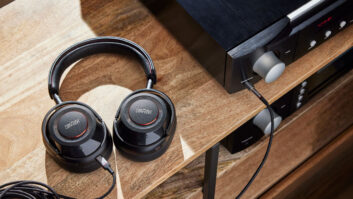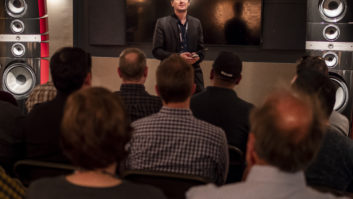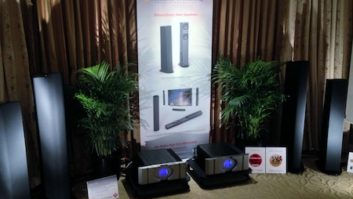The Latest Headphones Offer Profit Potential if Demo’d Correctly
If this year’s Consumer Electronics Show is any indication, headphones are coming back in a big way. And I don’t just mean earbuds–I mean big honking over-the-ear cans that call to mind sitting cross-legged on the floor with the lights off, the black lights on, and Dark Side of the Moon cranked to 11. Chances are, though, anyone who stumbles into your store looking for a rocking home sound system thinks of headphones as those little white buds you stick in your ears on the go, or worse yet, aggressively advertised, plastic cups designed to drown out the drone of an airplane engine and perhaps play a little music as an added afterthought. If you want to sell headphones as a part of a complete high-end audio solution (and you do), you need to blow your clients’ minds (and hopefully not their eardrums) with a musical experience unlike anything they’ve heard before. The rules, of course, are completely different from crafting an engrossing two-channel or surround sound demo, though. This isn’t about wide, lifelike soundstages or aural landscapes that swaddle you from every angle–it’s about picking music that digs directly into your noggin and won’t let go.
Girl Talk: All Day

Think of Girl Talk’s All Day album as a personal DJ strapped to your head–a seamless hour-long barrage of some of the best musical mashups you’ve ever shaken your rump to. Think of Gregg Gillis’ latest transformative masterpiece as a personal DJ strapped to your head — a seamless hour-long barrage of some of the best musical mashups you’ve ever shaken your rump to.
Just a warning, though: you don’t want to strap this deft mix of modern hip hop, classic rock, and ’80s pop to a client’s head too close to closing time. You’ll have to fight to get the headphones off the heads of anyone who gets a taste of the brilliant opening, which pits Black Sabbath’s “War Pigs” against Ludacris’ “Move Bitch,” and heads from there into The Doors’s “Waiting For the Sun” layered over the Ramones’ “Blitzkrieg Bop,” with a deft segue into Missy Elliott’s “Get Ur Freak On.” And that’s just the beginning.
If that sounds like a jumbled mess, you obviously haven’t heard Girl Talk work yet. Every one of the 372 samples (allegedly–I didn’t count all of them) seems to have been hand-picked not only for how the beats match up, but also with a particular ear toward the way the stereo mixes intertwine to create a wholly hypnotic sonic experience, the treads of all the different genres slamming together in your cranium with perfect precision. And best of all, the album is being distributed for free at illegal-art.net (in MP3 format or FLAC, both broken down into individual tracks or available as one long uninterrupted file.)
Beastie Boys: Paul’s Boutique

Snag a copy of the 20th Anniversary re-mastered reissue of Paul’s Boutique from the Beastie Boys’ website (in FLAC or Apple Lossless format, no less) to hear why. Late-’80s white-boy rap probably isn’t the first thing that comes to mind when you think “audio demo,” but this seminal rap romp is the first album I turn to when testing out a new set of headphones. Snag a copy of the 20th Anniversary re-mastered reissue from the Beastie Boys’ website (in FLAC or Apple Lossless format, no less) to hear why.
The funky opening guitar riffs of “Hey Ladies” sit right in the center of your head, doing their funky thing for a few seconds, before flipping into a phase-shift that’ll tug on your brain like a Stretch Armstrong in the hands of a masochistic five-year-old with a grudge against pliable plastic and a penchant for bumping bass beats.
Björk: Medúlla

Nothing quite matches the intimacy and interesting textures of “Where is the Line” from Björk’s fifth solo studio album, Medúlla. Check out pretty much anything from this quirky Icelandic pixie for a perfect taste of what I’m talking about. Björk has said that her music is made “for headphones in the home,” and I’ll back her up on that. Pick a track at random from her unique body of eclectic experimental pop albums, and it’s nearly guaranteed to sound amazing on a set of high-quality cans. But for my money, nothing quite matches the intimacy and interesting textures of “Where is the Line” from her fifth solo studio album.
It begins with a breathy, a cappella opening that almost sounds like Björk is cooing right into your ear, with a haunting, pitch-shifted harmony underneath that nearly gets lost completely when forced to travel through the air from a set of speakers on the other side of the room.
What follows is a dense mix of angelic chanting, industrial grinding, and noteven- barely-danceable beats, all woven together in a sticky tapestry that turns your skull into what feels like a reverberating combination cathedral/discotheque packed with undulating pagans and pulse-pounding drums.
Frank Zappa: Apostrophe (’)

Frank Zappa: Apostrophe (’) is such an unabashed sonic orgy, don’t be surprised if you have trouble listening to Zappa on anything but an amazing set of headphones ever again. I don’t care if you’ve listened to the opening medley from this brilliant follow-up to Over-Night Sensation a million times–if you’ve never heard it through a good set of ’phones, you’re missing out on the unmitigated genius of Zappa’s skills behind the mixing board. And not just in the way the boopboop- ditty-doo-doo chants in “Don’t Eat the Yellow Snow” hover outside your head as the rest of the track swims around inside it, but also in the way Frank’s vocals wobble around just off-center all throughout “Nanook Rubs It;” the way Ruth’s vibraphone licks are doubled-up and just out of sync, making them dance to the left and right the rest of the mix; the way Frank uses hard leftright- and-center mixing to keep the rhythm guitar separate from the lead in “Father O’Blivion.” It’s such an unabashed sonic orgy, don’t be surprised if you have trouble listening to Zappa on anything but an amazing set of headphones ever again.





